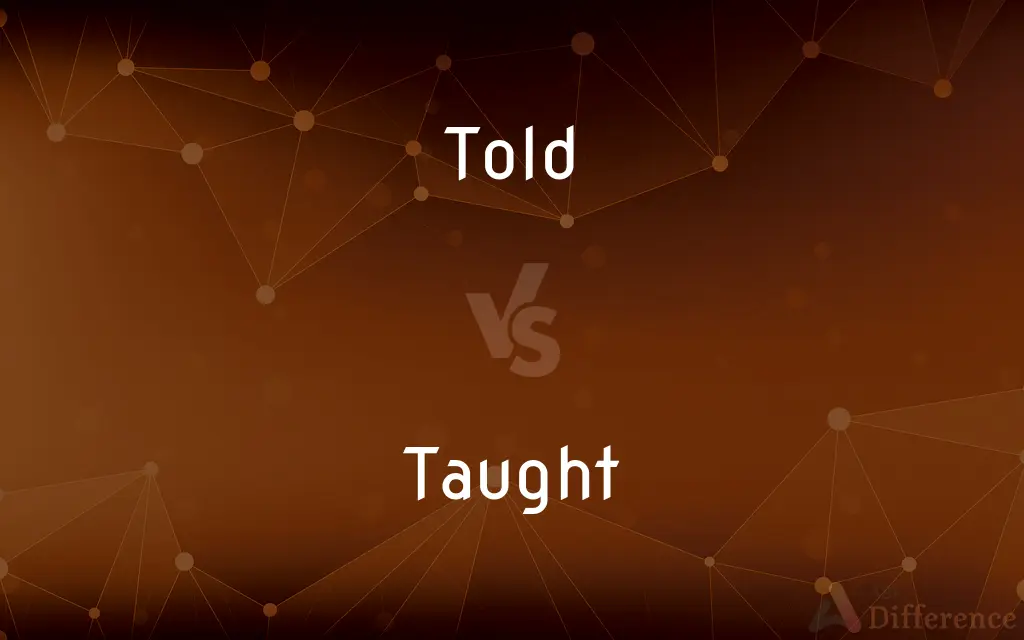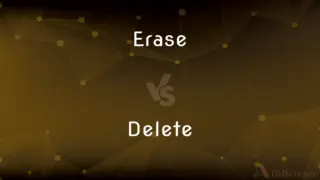Told vs. Taught — What's the Difference?
By Maham Liaqat & Urooj Arif — Updated on April 21, 2024
"Told" pertains to the act of conveying information through speech or writing, whereas "taught" involves instructing or educating someone, often implying a deeper engagement and learning process.

Difference Between Told and Taught
Table of Contents
ADVERTISEMENT
Key Differences
Told focuses on the transmission of information, whether it's facts, stories, or instructions, through verbal or written communication. Whereas taught involves not just telling but also ensuring understanding, typically requiring interaction and assessment to facilitate learning.
Told is a more general communication act that does not inherently require the listener's comprehension or feedback. On the other hand, taught assumes a level of responsibility on the part of the teacher to ensure that the learner grasps the content.
Told can be a one-way process where the speaker may not seek or require engagement from the audience. Whereas adaptability involves a dialogue, with teachers adapting their methods based on the learner's feedback and understanding.
Told often transmits knowledge or data without needing to confirm its assimilation. While taught engages with the learner, often using techniques designed to encourage deep understanding and retention of the material.
Told is effective for delivering straightforward, concise information or instructions. Whereas taught is suited for complex concepts that require comprehension, critical thinking, and application.
ADVERTISEMENT
Comparison Chart
Definition
Conveying information through words.
Instructing or educating with an aim of learning.
Communication
One-way, may not require feedback.
Interactive, often requires feedback.
Purpose
To inform or instruct simply.
To ensure understanding and application.
Engagement
Minimal, does not require listener's engagement.
High, involves active participation.
Method
Verbal or written transmission.
Educational techniques, practice, and evaluation.
Compare with Definitions
Told
News reporters are professionals who have told the public about current events.
The journalist told viewers about the election results.
Taught
Being taught often includes demonstrations and practice.
She was taught how to solve complex math problems.
Told
Being told something usually involves receiving information without needing to interact.
She was told the office would close at 5 PM.
Taught
Coaches are important for athletes being taught specialized techniques.
The sprinter was taught proper form to increase speed.
Told
Instructions are often told to ensure clarity and direction.
He was told to complete the form and return it.
Taught
Teachers are essential for students being taught in schools.
The students were taught French by Mr. Bell.
Told
In legal contexts, being told the rules is crucial for compliance.
Visitors are told to refrain from taking photographs.
Taught
Workshops are environments where skills are specifically taught.
They were taught pottery in a weekend workshop.
Told
Storytelling involves being told narratives that entertain or educate.
The children were told a story about honesty and bravery.
Taught
Self-taught individuals learn through their own efforts without formal instruction.
He taught himself programming through online courses.
Told
Past tense and past participle of tell1.
Taught
Past tense and past participle of teach.
Told
Simple past tense and past participle of tell
A tale is but half told, if only one person tells it.
Taught
Simple past tense and past participle of teach
Taught
See Taut.
Taught
(all used chiefly with qualifiers `well' or `poorly' or `un-') having received specific instruction;
Unschooled ruffians
Well tutored applicants
Common Curiosities
What does it mean to be told something?
Being told something means receiving information or instructions verbally or in writing.
Why is it important to differentiate between told and taught?
Differentiating helps clarify the depth of communication and engagement expected in educational contexts versus simple information sharing.
How does technology impact being told and taught?
Technology expands the methods and reach of both telling and teaching, through digital media and interactive platforms.
What are examples of environments where you are told rather than taught?
Briefings, announcements, and some forms of advertising are environments where information is told.
Is being taught more effective than being told?
For complex learning and understanding, being taught is typically more effective because it involves interaction and reinforcement.
Can telling be part of teaching?
Yes, telling can be a component of teaching, but teaching requires additional steps to ensure comprehension and application.
What does it mean to be taught?
Being taught refers to receiving education or training under the guidance of a teacher.
Can someone be effectively taught without being told?
Being told is usually a preliminary step in teaching, providing the basic information necessary for further exploration and learning.
How can one improve their teaching methods from merely telling?
Improving teaching methods involves incorporating interactive elements, practical applications, and continuous feedback.
What skills do teachers need that go beyond telling?
Teachers need skills in engagement, assessment, and adaptation to meet diverse learning needs.
In what context is it more appropriate to tell rather than teach?
Simple, straightforward information or instructions can be effectively communicated by just telling.
What are examples of environments where you are taught rather than told?
Classrooms, training seminars, and workshops are environments where participants are taught.
What impact does being taught have on long-term memory compared to being told?
Being taught typically has a greater impact on long-term memory due to the engagement and repeated exposure to the material.
How does the listener’s role differ in being told versus being taught?
In being told, the listener’s role is more passive, while being taught involves active participation and engagement.
What are the challenges of transitioning from telling to teaching in professional settings?
The challenges include developing deeper engagement strategies, creating interactive learning opportunities, and measuring the effectiveness of teaching methods.
Share Your Discovery

Previous Comparison
Erase vs. Delete
Next Comparison
Lurk vs. SkulkAuthor Spotlight
Written by
Maham LiaqatCo-written by
Urooj ArifUrooj is a skilled content writer at Ask Difference, known for her exceptional ability to simplify complex topics into engaging and informative content. With a passion for research and a flair for clear, concise writing, she consistently delivers articles that resonate with our diverse audience.















































